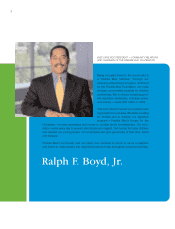Freddie Mac 2004 Annual Report Download - page 20
Download and view the complete annual report
Please find page 20 of the 2004 Freddie Mac annual report below. You can navigate through the pages in the report by either clicking on the pages listed below, or by using the keyword search tool below to find specific information within the annual report.thus the speciÑc characteristics of the mortgages underlying those PCs, are not known (i.e., not ""announced'')
at the time of the trade, but only subsequently when the trade is to be settled.
While the majority of TBA trades are performed manually, with purchases and sales occurring through
direct contact between or among the parties to the trade, dealers often trade as anonymous participants
through an inter-dealer broker or electronic trading system.
Purchases and sales of TBA-eligible PCs occur daily. Prices are generally quoted and accepted based only
upon the name of the issuer (e.g., Freddie Mac), the type of PC (e.g., 30-year Ñxed rate), the coupon of the
PC, the quantity and the settlement month. Each type of TBA trade has a single designated settlement date in
each month, and 48 hours before the settlement date the parties identify the speciÑc PCs to be delivered to
fulÑll the TBA trade obligation. During 2004 and 2003, we issued approximately $272.2 billion and $564.3
billion, respectively, of PCs that were eligible to be delivered to settle TBA trades, representing approximately
76 percent and 80 percent, respectively, of our total PC issuances.
Lenders use the TBA market to hedge the risk of changes in the fair value of mortgage loans caused by
Öuctuations in mortgage interest rates that occur after the lender ""locks'' a mortgage interest rate with a
borrower, but before the mortgage loan is originated. When a lender locks in a rate for a borrower, the lender
may sell PCs in the TBA market for delivery at a future date. After the lender originates the mortgages, it
delivers the mortgages to us in a swap transaction and receives PCs in return. Those PCs can then be used to
settle the TBA trade, or the lender can settle the trade with any of our other existing PCs that meet the
generic terms of the trade.
We use the TBA market to manage cash purchase transactions. When a lender commits to deliver
mortgages to us in exchange for cash at a speciÑed price, we may sell PCs in the TBA market for delivery at a
future date. By using the TBA market, we can manage the risk of Öuctuations in interest rates by locking in
the price at which we will sell the PCs that will ultimately be formed from the mortgages we purchase from
lenders in cash transactions.
The use of the TBA market increases the liquidity of mortgage investments and improves the distribution
of investment capital available for residential mortgage Ñnancing, thereby helping us to accomplish our
statutory mission.
Portfolio Investment Activities
We purchase mortgage loans and mortgage-related securities (including PCs and Structured Securities
we previously issued to third parties) and hold them in our Retained portfolio for investment purposes. We
Ñnance these purchases by issuing short-, medium- and long-term debt and subordinated debt and equity
securities. Our purchases of mortgage loans and mortgage-related securities replenish the sources of capital
available for mortgage lending to consumers.
Our Retained portfolio is managed through a disciplined strategy of long-term capital deployment. We
apply our mortgage market expertise to support our asset selection while managing our credit and interest-rate
risk. We invest in agency securities, non-agency mortgage-related securities and whole mortgage loans.
Agency securities are mortgage-related securities issued by GSEs or governmental agencies.
We manage interest-rate risk and reduce the funding cost of the debt we issue by:
‚ issuing a mixture of debt of various maturities, either callable (that is, redeemable at our option at one
or more times before its scheduled maturity) or non-callable;
‚ using a variety of derivatives; and
‚ restructuring mortgage-related securities cash Öows and retaining a portion of these restructured cash
Öows in the form of Structured Securities.
See ""MD&A Ì RISK MANAGEMENT Ì Interest-Rate Risk and Other Market Risks'' for more
information.
Freddie Mac
8
























